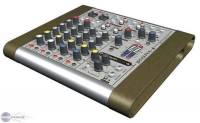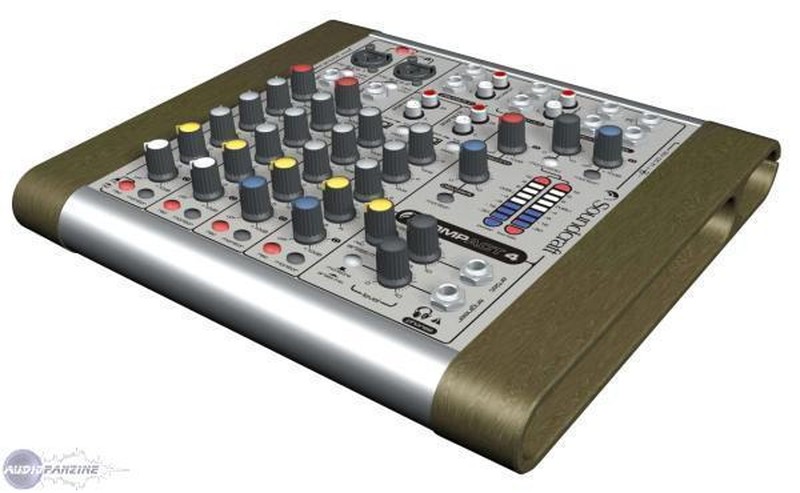AudioCOMPACT4 SOUNDCRAFT 2 mic 2 line stereo mixer


Quantity
ex
Project List Available
Description
Characteristics
Share
Product file
The Soundcraft COMPACT 4 mixer is perfectly suited to many applications requiring simple mix facilities, but it comes into its own when used for recording vocals and music onto computers using a soundcard.
Several features have been specifically incorporated for this. Firstly, it’s simple to route an input straight to the record output simply by selecting the RECORD button on the channel.
Secondly, a wide variety of input sources are catered for on this simple 4-input mixer. These include microphone, line, and a special ‘DI’ or ‘Direct’ input for guitars and keyboards, plus stereo inputs for keyboards, CD/tape, or turntable (with RIAA equalisation). This DI input matches the input impedance of the mixer to the output impedance of the instrument, ensuring optimum professional-quality audio capture.
Thirdly, listening while recording is made easier thanks to a special blend control that allows you to control the mix of the computer playback mix and the signal of the track being recorded which are blended for the Artist headphone output.
Using an external analogue mixer for computer recording means zero-latency monitoring. That is that you can listen to your track being recorded simultaneously with the playback from the computer, without the inherent signal delay of the computer soundcard and host processor.
A larger model, the COMPACT 10, features 4 mono and 6 stereo inputs, with additional line input ¼” jack sockets on 4 of the stereo inputs.
Other standard features on the COMPACT include 3 band EQ on the inputs, along with professional 48V phantom power for condenser microphones, dedicated balanced and unbalanced Record and Playback connections, independent engineer & artist headphone outputs, and monitor outputs. The dual headphone feeds provide a level of monitoring normally found in large commercial studios.
All monitoring is in true stereo, rather than the mono-summed monitoring found on competitive products. This means that what you hear is always as it will be in your final master.
For product availability and pricing please contact your local dealer.
Several features have been specifically incorporated for this. Firstly, it’s simple to route an input straight to the record output simply by selecting the RECORD button on the channel.
Secondly, a wide variety of input sources are catered for on this simple 4-input mixer. These include microphone, line, and a special ‘DI’ or ‘Direct’ input for guitars and keyboards, plus stereo inputs for keyboards, CD/tape, or turntable (with RIAA equalisation). This DI input matches the input impedance of the mixer to the output impedance of the instrument, ensuring optimum professional-quality audio capture.
Thirdly, listening while recording is made easier thanks to a special blend control that allows you to control the mix of the computer playback mix and the signal of the track being recorded which are blended for the Artist headphone output.
Using an external analogue mixer for computer recording means zero-latency monitoring. That is that you can listen to your track being recorded simultaneously with the playback from the computer, without the inherent signal delay of the computer soundcard and host processor.
A larger model, the COMPACT 10, features 4 mono and 6 stereo inputs, with additional line input ¼” jack sockets on 4 of the stereo inputs.
Other standard features on the COMPACT include 3 band EQ on the inputs, along with professional 48V phantom power for condenser microphones, dedicated balanced and unbalanced Record and Playback connections, independent engineer & artist headphone outputs, and monitor outputs. The dual headphone feeds provide a level of monitoring normally found in large commercial studios.
All monitoring is in true stereo, rather than the mono-summed monitoring found on competitive products. This means that what you hear is always as it will be in your final master.
For product availability and pricing please contact your local dealer.
balancethe relative levels of the left and right channels of a stereo signal.balanceda method of audio connection which ‘balances’ the wanted signal between two wires and a screen whichcarries no signal. Any interference is picked up equally by the two wires, which results in cancellation of theunwanted signal. In this guide, the term can refer to various circuit architectures. Connection details are givenin relevant sections.busa pair of stereo channels, on which signals are mixed together and travel to designated destination.clippingthe onset of severe distortion in the signal path, usually caused by the peak signal voltage being limited by thecircuit’s power supply voltage.DATDigital Audio Tape, a cassette-based digital recording format.dB (decibel)a ratio of two voltages or signal levels, expressed by the equation dB=20Log10 (V1/V2). Adding the suffix ‘u’denotes the ratio is relative to 0.775V RMS.DI(direct injection)/DI Box the practice of connecting an electric musical instrument directly to the input of the mixing console, rather thanto an amplifier and loudspeaker which is covered by a microphone feeding the console.equalisera device that allows the boosting or cutting of selected bands of frequencies in the signal path.fadera linear control providing level adjustment.feedbackthe `howling’ sound caused by bringing a microphone too close to a loudspeaker driven from its amplifiedsignal.foldbacka feed sent back to the artistes via loudspeakers or headphones to enable them to monitor the sounds they areproducing.frequency responsethe variation in gain of a device with frequency.gainthe amount of amplication in level of the signal.headroomthe available signal range above the nominal level before clipping occurs.impedance balancinga technique used on unbalanced outputs to minimise the effect of hum and interference when connecting toexternal balanced inputs.inserta break point in the signal path to allow the connection of external devices, for instance signal processors orother mixers at line level signals. Nominal levels can be anywhere between-0dBu to +6dBu, usually coming from a low impedance source.pan (pot)abbreviation of ‘panorama’: controls levels sent to left and right outputs.peakingthe point at which a signal rises to its maximum instantaneous level, before falling back down again. It canalso describe an equaliser response curve affecting only a band of frequencies, (like on a graphic equaliser),“peaking” at the centre of that band. TYPICALSPECIFICATIONS Noise (22Hz-22kHz measurement bandwidth) Mic EIN @ max gain, 150 ohm source impedance:-128dBuMix Mix@ unity, faders down :<-85dBuCrosstalk Crosstalk (typ. @ 1kHz) Fader cut-off (rel +10 mark) :>80dB Frequency response Mic/Line input to any output :+/- 0.5dB 20Hz – 20kHz THD+Noise Mic gain 30dB Mix out, fader max @ 1kHz: <0.007 % Input & output Impedances mic input :2kΩ Line input :>10kΩ Hi-Z input: >300kΩ Stereo input 47kΩ Outputs: 75Ω Input & output levels Mic input max level +16dBu Line input max level :+30dBu Stereo input max level :+20dBu Mix output max level :+20dBu Headphones (@ 200Ω) :300mW EQ Bands +/- 12dB Lo 60Hz Mid 600Hz Hi :12kHz Weight COMPACT4:1.75 kg(3.85lb) COMPACT10 :2.75kg (6.05lb) AVERAGE POWER CONSUMPTION (QUIESCENT) COMPACT4: 8 Watts COMPACT10 :14 Watts MIN / MAX TEMPERATING TEMPERATURE (E SERIES FAMILY) centigrade/Farenheit : 0°C - 50°C / 32°F - 122°F